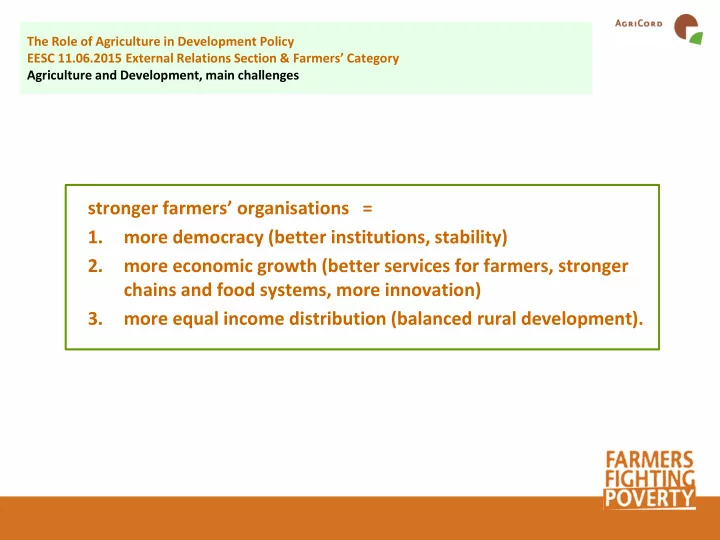

The Role of Agriculture in Development Policy EESC 11.06.2015 External Relations Section & Farmers’ Category Agriculture and Development, main challenges stronger farmers ’ organisations = 1. more democracy (better institutions, stability) 2. more economic growth (better services for farmers, stronger chains and food systems, more innovation) 3. more equal income distribution (balanced rural development).
Members Farmers ’ organisations Country Since ACODEA UPA, FADEMUR, Cooperativas Agro-Alimentarias Spain 2014 AFDI FNSEA, APCA, Jeunes Agriculteurs, CNMCCA France 2003 AGRITERRA LTO, SSVO, NCR and NAJK Netherlands 2003 AHA DBV Deutscher BauernVerband Germany 2014 ASIADHRRA AFA Asian Farmers Association for Sustainable Rural Development Asia 2011 ASPRODEB Organisations agricoles du Sénégal membres d’Asprod eb Senegal 2011 CSA FWA Fédération Wallonne d’Agriculture Belgium 2010 FERT Groupe Céréaliers de France (AGPB, AGPM, ARVALIS, UNIGRAINS) France 2003 FFD MTK, SLC, Pellervo, ProAgria Finland 2013 TRIAS Boerenbond, Landelijke Gilden, KVLV and KLJ Belgium 2003 UPA DI UPA Union Professionnelle Agricole (Québec) Canada 2003 WE EFFECT LRF Federation of Swedish Farmers Sweden 2004 Associated member CIA Confederazione Italiana Agricoltori Italy 2009
AgriCord = focus on one actor membership based organisations of family farmers Table 1.1 Numbers of farmers’ organisations and projects registered under FFP, by region, 2012 - 2014 Farmers' organisations Projects Continent 2012 2013 2014 2012 2013 2014 Africa 119 127 131 142 160 161 Asia 30 31 39 33 37 51 Europe 6 7 8 6 8 8 Latin America/Caribbean 33 31 27 36 35 32 Total 188 196 205 217 240 252
Outreach = number of man and women farmers directly participating in project activities Table 1.10 Registered outreach for 2013 for each work area Work area Registered WA1: Organisational strength and inclusiveness 223,090 31.4% WA2: Institutional development 1,433 0.2% WA3: Policy elaboration and advocacy 53,557 7.5% WA4: Farmer-led economic activities 431,469 60.8% Total 709,549 100.0%
Monitoring of strengthening processes: 17 deliverables, with measurable targets Del.01-5 (5) Membership base (222 registrations) The FO has an active and representative membership, mandated by and structurally aligned with well functioning local basic groups with increased membership base. Target # Planned Realised Local groups established (number) 124 24,658 25,610 104% Number of primary coops (number) 46 1,042 1,012 97% Increased membership (m/f/t) 36 414,841 410,123 99% Good quality groups (%) 8 52% 55% 105% Local groups represented (y/n) 4 4 4 100% Members satisfied with services (%) 4 85% 61% 72% Total 222 101%
Monitoring of strengthening processes: 17 deliverables, with measurable targets Del.04-4 (16) Marketing (198 registrations) The FO leads collective action to improve product marketing (better conditions including price, timely marketing, more value added and shorter chain) to increase the market power of family farmers and to achieve higher incomes. Target # Planned Realised Business plan to improve marketing (y/n) 58 37 28 76% Number of linkages with market outlet (number) 47 970 962 99% Chain analysis for key product (y/n) 41 31 26 84% Access to market information (y/n) 38 28 21 75% Local groups with increased market volume (y/n) 7 4 3 75% Local groups with trade contracts / deals (number) 5 30 29 97% Local groups in agribusiness clusters (number) 2 5 0 0% Total 198 83%
support to farmers’ organisations support to farmers’ organisations is effective is efficient [ impact and outreach ] [ key competences ] General averages 2009 2014 1. N ETWORKING 6. I NCLUSIVENESS 2. P ARTICIPATION 3. 5. R ESULTS A CCOUNTABILITY 4. P ROFESSIONAL CAPACITY
Competence Leading indicator Meaning Is the organisation a representative organisation, with a 1. Representativity 1. Representativity indicator significant proportion of farmers in its membership? 2. Participation 2. Participation indicator Does the organisation involve its members? 3. Accountability 3. Accountability indicator Does it report back to its members? 4. Inclusiveness 4. Diversity indicator Does it involve women and youth? 5. Professionalism 5. Professional capacity indicator Is it a professional organisation? 6. Financial Sustainability 6. Income diversification indicator Does it obtain income from other sources than donors? 7. Financial solidity indicator What is the financial sustainability of the organisation? 7. Networking 8. Networking indicator Does it relate to other actors? 9 Results indicator Does it provide useful services?
how ? (1) how ? (2) • • peer-to-peer support between ensure complementarities with professional organisations public programs, synergies with government • strong focus on food chain • development, incl. contract mobilise investments from farming, innovation banks and private sector, using grant funding • demand-driven by membership- • based farmers’ organisations and promote family farming and cooperatives. rural entrepreneurship.
Recommend
More recommend